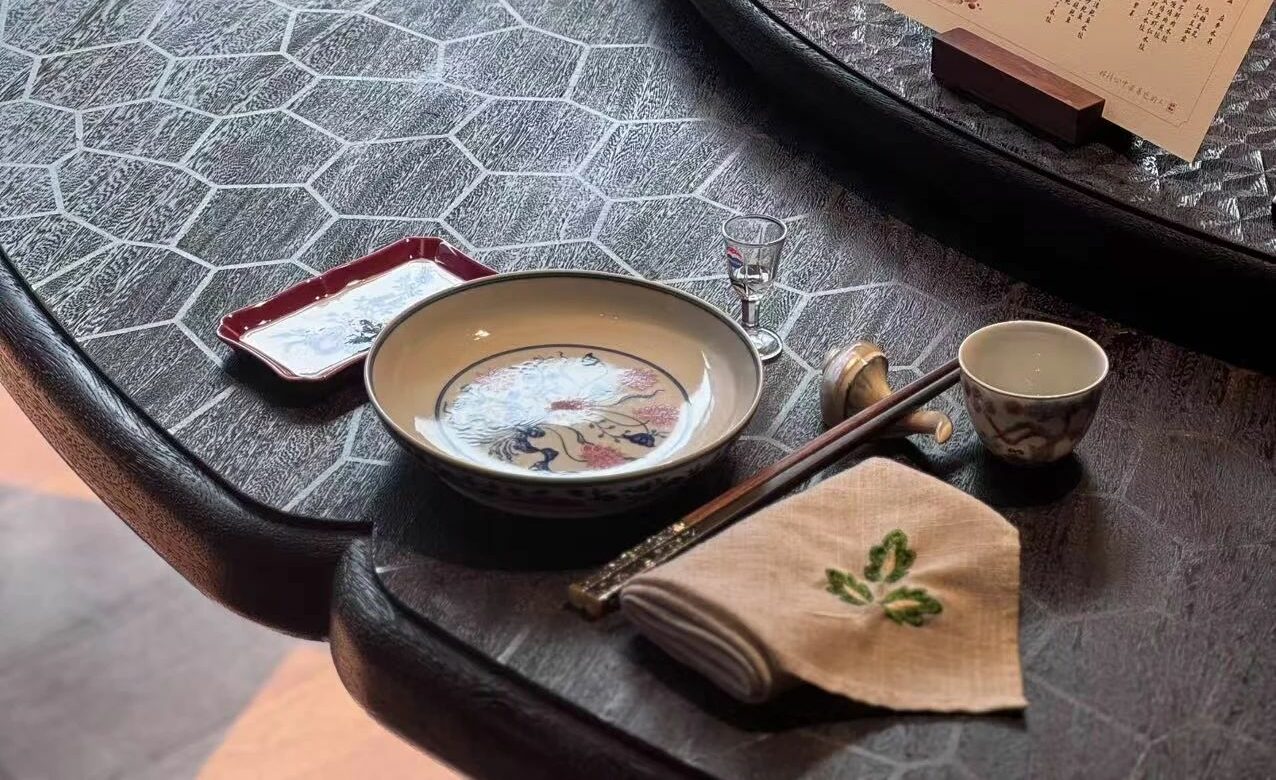Author:Jocelyn Chen
Preface:
The last time I visited Xin Rong Ji Taizhou was before the pandemic. I could still recall the beautiful time I spent at the restaurant. New venues have been introduced in the past two years: four sub-brands in three cities in 2020; another four brands in four cities this January. Xin Rong Ji has gradually developed its own universe with its level-headed expansion and true craftsmanship. As a frequent visitor of the restaurant, I trust myself in testifying the sense of satisfaction brought by its delicious seasonal ingredients, consistent performance and warm service.This time I had the chance to interview Mr. Zhang Yong at Xin Rong Ji Linghu in Taizhou. Before I even started, Mr. Zhang had already introduced to me a brand-new world of Xin Rong Ji.To date, Xin Rong Ji has received a total of 12 Michelin stars across its eight locations in Beijing, Shanghai and HongKong. In terms of high-end restaurant groups in a global scale, Xin Rong Ji comes at the fourth place, after the most-starred late chef Joël Robuchon, followed by Alain Ducasse with 17 stars, Pierre Gagnaire with 14 stars, and alongside Martin Berasategui in Spain with 12 stars as well. Without doubt, Xin Rong Ji is a precious gem for Chinese cuisine.Let us now once again unveil how Xin Rong Ji was born.
Mr. Zhang:We are now in my birth place, Linhai, Taizhou. The first Xin Rong Ji restaurant was opened here in this city on the 1st of October 1995. The place we are now at is in the new town. The first restaurant was in the old town. It was only a few hundred square meters.The reason I opened this restaurant was that I love good food. Back then I couldn’t afford to open a big, beautiful restaurant, so I thought owning a compact one, where I could cook good food for friends and other guests, would also be great.



Why is it called Xin Rong Ji? I was in Guangdong most of the time, and I saw many restaurant names ending with “Ji” (showing ownership in Chinese). I thought maybe I could use “Yongji” (i.e. the owner’s name), but “Yong” (being brave) is a bit ordinary. “Rong” (meaning thriving) and “Yong” are homophonic in the Taizhou dialect, but “Rong” is more elegant. With the addition of “Xin”, which means new and thriving, we had Xin Rong Ji as the name.
Jocelyn:So, it’s been 27 years now?
Mr. Zhang:27 years. We started the business because we really love what we do.
1
Taizhou – Xin Rong Ji’s Universe
Mr. Zhang:Taizhou is part of the East China Sea, which is close to Ningbo, Zhoushan, Taizhou and Wenzhou in Zhejiang Province. These are the four major cities along the East China Sea coastline. Then if you go further south from Ningbo, there is the South China Sea, which is next to Fujian. People tend to think that the seafood from the East China Sea is different from the seafood in Guangdong. But why? Does the seafood from the South China Sea taste any better?


The winding, rugged coastline of the East China Sea, especially the part near Taizhou, harbors a lot of islands where smaller forage fish group is abundantly produced. Bigger seas are home to larger predator fish. The sea here is not as clear as the South China Sea, as you know Hainan Island is very beautiful, right? The sea here is a bit turbid. What determines whether the seafood is good or not? The temperatures, the salinity, and the currents passing by. Seafood from the East China Sea easily die once harvested, but they have very good aftertaste. Many people used to go to Chaozhou to place seafood orders, and now they come to Taizhou.
Jocelyn:I think so. They have a fresh, clean taste. But it’s quite nuanced.
Mr. Zhang:When we were selling seafood in Hong Kong, the local people were full of doubts to us, because we were selling dead fish at a higher price than living fish. For example, dead yellow croaker was sold at a higher price than coral grouper and napoleon fish, and many people couldn’t accept that. Then in Hong Kong there is also a local yellow croaker, which they call Huanghuayu, which is very cheap, a few hundred HK dollars a kilo. But the price can vary a lot if the originating sea area is different. Nowadays, Hong Kong diners are willing to pay for the yellow croaker dish when they come to Xin Rong Ji.
At the end of the day, customers either from Hong Kong or from other places, will come to realize what good stuff is. Especially Hong Kong people, they will eventually accept what you do if what you are selling is good enough.



“……we are open to what we
consider as good.”
Jocelyn:What percentage of Xin Rong Ji’s ingredients are coming from Taizhou?
Mr. Zhang:At the beginning, it was basically all of them. As we expand, we now source quality ingredients from across China and the world. Initially we mainly used seafood from the East China Sea but now it’s all over the country. Of course, we are still very much focused on Taizhou produce because we know them the best, but there doesn’t have to have geographical boundaries – we are open to what we consider as good.



For example, we handle very well Yunnan mushrooms and Italian white truffles. Caviar and foie gras are less used. At first, people couldn’t relate white truffles to Chinese food, as they are supposed to be seen in French or Italian cuisine. They thought truffles should have nothing to do with Xin Rong Ji, a Chinese restaurant specializing in seafood dishes. But actually, we did sell it quite well.
Jocelyn:Next time I should order more truffle dishes here.
Mr. Zhang:Back then our customers would say something like: “Why go to Xin Rong Ji for white truffles? I should just find a French or Italian restaurant.” The way we interpret white truffles is different from western restaurants, and now customers flock at our door when it’s white truffle season.
Jocelyn:The Home-style Radish dish goes well with white truffles.
Mr. Zhang:You were the one who brought up this suggestion to me right? I think it’s you. You said radish and white truffle should be an interesting pair.
Jocelyn:It’s perfect for fried rice, because in Italy they put white truffles in risotto and eggs. Xin Rong Ji combines rice with eggs and white truffles, so perfect combination.
“This flavour is universally
accepted by customers.”
Jocelyn:Many people ask, “What is Taizhou cuisine?” Even the eight major cuisines are not widely acknowledged nowadays, how do you go about telling people what Taizhou cuisine is, what features it has or what strengths it’s got?

Mr. Zhang:Many used to think that there was no Taizhou cuisine. There were two cuisine types that were most popular in Zhejiang province, one being Hangzhou cuisine, which is the representative of Zhejiang cuisine, another being Wenzhou cuisine, which was also called “western” cuisine because of Wenzhou’s economic prosperity and abundant seafood. There was no Taizhou cuisine at all.
But is Taizhou cuisine good? It is very good now. Taizhou cuisine has only been around for a relatively short time. It has incorporated elements from elsewhere and formed its own style with limited creation of its own.
Mr. Zhang:What are its features? The key lies in the ingredients. Backing the mountains and facing the sea, Taizhou has warm summers and cold winters, so the local produce is very distinctive. This is nature’s bestowal, not something you can acquire.


Second, Taizhou cuisine is mainly rich and umami. This is my own conclusion. Ningbo seafood is salty and umami because it relies heavily on salt. Chaozhou seafood is also salty, but the flavour is enhanced more by fermented sauces like fish sauce, Puning bean paste, sour lime and salted lemon. To be honest, I would think this is a higher level of seasoning than just using salt.
Jocelyn:Simply put, the original flavour of the ingredients.
Mr. Zhang:Yes, that’s right.
Jocelyn: Would you say this is the biggest strength of Taizhou cuisine?
Mr. Zhang:Rich, umami and pure. You can never get bored by original flavours.
“Everybody orders it,……
Our customers really love this dish.”

If you want to venture for something heavier, go for Braised Sea Anemones with Sweet Potato Noodles. Everybody orders it, but after all these years I am still a bit hesitant about it. Our customers really love this dish. Personally, I prefer yellow croaker, although the meat is not as delicate as the fish from the South China Sea. The unique flavour of yellow croaker is the most precious thing about it.

What’s so great about white truffles? It’s the charming, earthy, pungent aroma. It doesn’t taste any better than potatoes, but strange thing is, if you mix a bowl of rice or noodles with warm yellow croaker sauce, it works even better than abalone sauce.The originality and richness of the flavours is reflected in these three dishes, I think.
Jocelyn:They are also must-orders for me. Last time I was in Shanghai and I didn’t get to order the crispy cutlass fish as it was already sold out.
Mr. Zhang:We choose different cutlass fish for different seasons. Cutlass fish is a delicacy that’s given to us by nature. In summer, when we can’t trawl, we go fishing in the sea. Sea cutlass fish is relatively small, about 300g-350g in weight, and it has this scale-less, silky, shiny skin. This kind of cutlass fish is very good.Another kind of cutlass fish, which is also very good, is the kind harvested around the winter solstice. That’s when it’s at its fattest and reaches puberty or maturity.
Jocelyn:It’s interesting because we can eat good quality cutlass fish during banned commercial fishing periods.
Mr. Zhang:Cutlass fish is really good during the banned periods because of the sea fishing. It may not be as fatty but the taste is splendid.

(To be continued…)
Interivew / Edit:Jocelyn Chen
Edit:Ivy Zhu
Photo: Ye Shi











